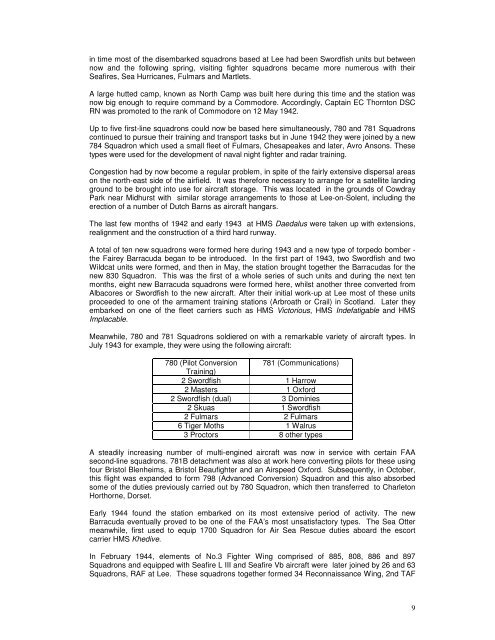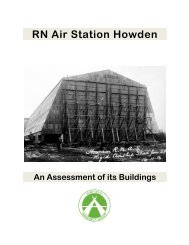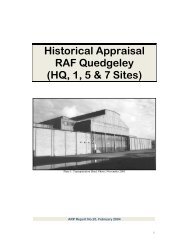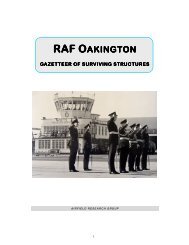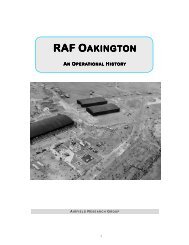RNAS Lee - The Airfield Research Group
RNAS Lee - The Airfield Research Group
RNAS Lee - The Airfield Research Group
You also want an ePaper? Increase the reach of your titles
YUMPU automatically turns print PDFs into web optimized ePapers that Google loves.
in time most of the disembarked squadrons based at <strong>Lee</strong> had been Swordfish units but between<br />
now and the following spring, visiting fighter squadrons became more numerous with their<br />
Seafires, Sea Hurricanes, Fulmars and Martlets.<br />
A large hutted camp, known as North Camp was built here during this time and the station was<br />
now big enough to require command by a Commodore. Accordingly, Captain EC Thornton DSC<br />
RN was promoted to the rank of Commodore on 12 May 1942.<br />
Up to five first-line squadrons could now be based here simultaneously, 780 and 781 Squadrons<br />
continued to pursue their training and transport tasks but in June 1942 they were joined by a new<br />
784 Squadron which used a small fleet of Fulmars, Chesapeakes and later, Avro Ansons. <strong>The</strong>se<br />
types were used for the development of naval night fighter and radar training.<br />
Congestion had by now become a regular problem, in spite of the fairly extensive dispersal areas<br />
on the north-east side of the airfield. It was therefore necessary to arrange for a satellite landing<br />
ground to be brought into use for aircraft storage. This was located in the grounds of Cowdray<br />
Park near Midhurst with similar storage arrangements to those at <strong>Lee</strong>-on-Solent, including the<br />
erection of a number of Dutch Barns as aircraft hangars.<br />
<strong>The</strong> last few months of 1942 and early 1943 at HMS Daedalus were taken up with extensions,<br />
realignment and the construction of a third hard runway.<br />
A total of ten new squadrons were formed here during 1943 and a new type of torpedo bomber -<br />
the Fairey Barracuda began to be introduced. In the first part of 1943, two Swordfish and two<br />
Wildcat units were formed, and then in May, the station brought together the Barracudas for the<br />
new 830 Squadron. This was the first of a whole series of such units and during the next ten<br />
months, eight new Barracuda squadrons were formed here, whilst another three converted from<br />
Albacores or Swordfish to the new aircraft. After their initial work-up at <strong>Lee</strong> most of these units<br />
proceeded to one of the armament training stations (Arbroath or Crail) in Scotland. Later they<br />
embarked on one of the fleet carriers such as HMS Victorious, HMS Indefatigable and HMS<br />
Implacable.<br />
Meanwhile, 780 and 781 Squadrons soldiered on with a remarkable variety of aircraft types. In<br />
July 1943 for example, they were using the following aircraft:<br />
780 (Pilot Conversion<br />
Training)<br />
781 (Communications)<br />
2 Swordfish 1 Harrow<br />
2 Masters 1 Oxford<br />
2 Swordfish (dual) 3 Dominies<br />
2 Skuas 1 Swordfish<br />
2 Fulmars 2 Fulmars<br />
6 Tiger Moths 1 Walrus<br />
3 Proctors 8 other types<br />
A steadily increasing number of multi-engined aircraft was now in service with certain FAA<br />
second-line squadrons. 781B detachment was also at work here converting pilots for these using<br />
four Bristol Blenheims, a Bristol Beaufighter and an Airspeed Oxford. Subsequently, in October,<br />
this flight was expanded to form 798 (Advanced Conversion) Squadron and this also absorbed<br />
some of the duties previously carried out by 780 Squadron, which then transferred to Charleton<br />
Horthorne, Dorset.<br />
Early 1944 found the station embarked on its most extensive period of activity. <strong>The</strong> new<br />
Barracuda eventually proved to be one of the FAA’s most unsatisfactory types. <strong>The</strong> Sea Otter<br />
meanwhile, first used to equip 1700 Squadron for Air Sea Rescue duties aboard the escort<br />
carrier HMS Khedive.<br />
In February 1944, elements of No.3 Fighter Wing comprised of 885, 808, 886 and 897<br />
Squadrons and equipped with Seafire L III and Seafire Vb aircraft were later joined by 26 and 63<br />
Squadrons, RAF at <strong>Lee</strong>. <strong>The</strong>se squadrons together formed 34 Reconnaissance Wing, 2nd TAF<br />
9


